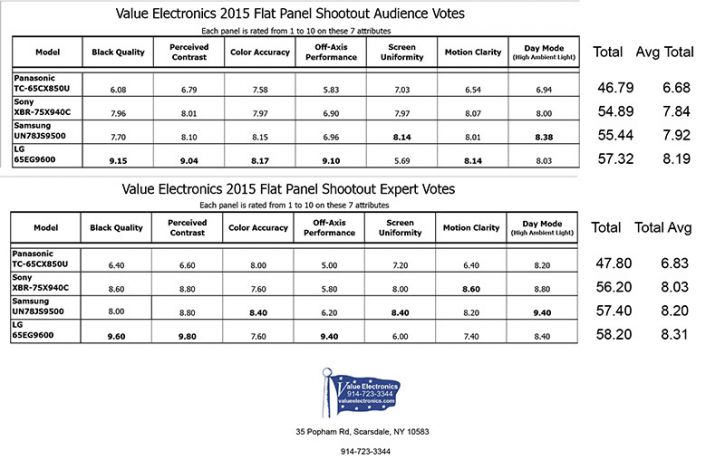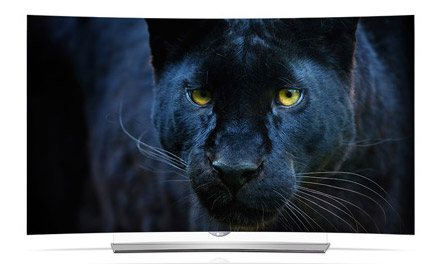At this year's TV Shootout, hosted by Value Electronics at the CE Week event in New York City, video enthusiasts, members of the press and the CE trade gathered to check out some of the highest performance televisions on the market today. 4K Ultra HD TV sets from Sony, Samsung, Panasonic and LG were all assembled in a room, calibrated professionally for peak performance and hit with a variety of test patterns and real world content to see which set produced the best overall picture. More details on the shootout can be found in our earlier article on the subject.
During the shootout, audience members were asked to score the various picture quality elements of each set from 1 to 10 in order to create composite scores for each set. Now the votes are in and the ballots have been counted, and it looks like the LG EG9600 OLED Ultra HDTV took home the prize for the "King of TV" for 2015 with the highest average score. The ranking was the same both for the "expert votes" (TV reviewers, CE journalists and other industry experts) and for the standard consumer votes.
The results are included in the following table:

Having attended the event myself, I must say my own opinions of the sets' performance in this environment closely tracked these results. While the OLED set did have some issues with absolute color accuracy (which was only visible on select content, and was apparently not noticed by many voters), motion clarity and image uniformity (again, only with certain content), its deep inky black levels, excellent perceived contrast and outstanding off-axis performance gave it the edge in overall picture quality over the LED/LCD sets.
The Samsung and Sony sets -- which scored quite close to the LG set overall -- performed better with overall image uniformity and motion reproduction but couldn't quite match the black level performance and perceived contrast of the OLED. Also, all three of the LED/LCD sets performed poorly for off-axis viewing. While the Panasonic scored lowest in these particular tests, it also did produce a pleasing image in person, and sells for a fraction of the cost of the competition so it's still a worthy contender for your Ultra High Def dollars.
As to why the OLED scored highest in black level performance and perceived contrast? That comes down to the technology used to make the picture: transmissive vs. emissive. Transmissive technology (LED/LCD) transmits light from an LED backlight through an LCD panel in order to make a visible image. Emissive technology (OLED) emits light from each individual pixel directly. It needs no backlight because each individual picture element is bright enough to be visible.

When you use a backlight to produce an image, it's tricky to get really deep, dark black levels. "Black" on an LED/LCD TV tends to be more like dark grey due to some leakage of the backlight around the edges of the LCD shutters. This can be mitigated through the use of "local dimming" technology which turns down or turns off the backlight in particular areas of the screen when content requires that. But this can introduce its own artifacts such as haloing (glowing edges around bright images on a dark background).
Another side effect of transmissive technology like LED/LCD TVs is that they tend to suffer in image quality when viewed off-axis (from the sides) as opposed to viewing them head-on. Looking at a pure red image on the three LED/LCD TVs included in the competition, the picture shifted from red to pink to grey the further I moved to either side. Emissive picture techologies like plasma and OLED don't suffer from this issue: they maintain most of their black levels and color saturation even when viewed from the side.
LED-lit LCD TVs do offer advantages over OLED sets: currently LED/LCD TVs can reproduce a brighter image particular for peaks. This makes them naturally well-suited for the upcoming HDR (High Dynamic Range) Ultra HD content which we expect to start seeing more of later this year. Also, advances in motion processing allow some high-end LED/LCD sets to handle moving images better (with more detail) than current OLED sets. This was evident in this year's shootout with higher motion clarity scores going to the Sony and Samsung LED/LCD sets (at least among the expert votes). LED/LCD sets also tend to be more energy efficient than plasma or OLED TVs. But in terms of black levels and perceived contrast, OLED does still seem to have the edge.
Related Articles: